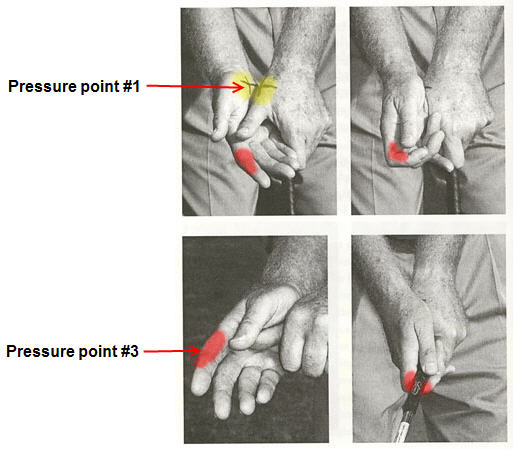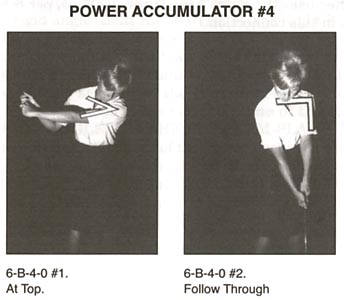6-C-1 PRESSURE POINTS The force to be applied for the movement of the Lever Assemblies -- both ways (opposite pressures 6-B-1-D) -- is exerted against the Club (7-11) through Pressure Points -- of which there are four:Here's the #1 and #3 Pressure Points
1. The heel of the Right Hand where it touches either the Left Hand thumb or the Clubshaft (as required by the Grip used.)
2. The last three fingers of the left hand.
3. The first joint of the Right Hand index finger where it touches the Clubshaft.
4. Wherever the straight Left Arm contacts the Left side

And here's the #4 Pressure Point.
The #4 Pressure point is different from the #4 Power Accumulator. The #4 pressure point is where the 'pressure' is between the left arm and left side connection. The #4 Power accumulator deals with the angle going from an acute angle to an obtuse angle as shown above.
A golfer can use any single pressure point or any combination of pressure points. 'Swingers' (left side pulling golf swing) primarily use the #2 and #4 Pressure Points. 'Hitters' primarily use the #1 and #3 Pressure Points. I suggest golfers really look into these pressure points. Before reading 'The Golfing Machine' I never utilized the #1 Pressure Point and since I have I've seen a little more increase in clubhead lag. I would imagine that many golfers are in the same boat. Or if you're a golfer that utilizes a 'swinging' technique, you may want to focus a little more on the #2 or #4 Pressure Points.
3JACK
1 comment:
PA4 doesn't make sense to me. It seems to me its the shoulder sockets that are being moved by the rotation of the hips/pelvis/ribcage (shoulders sit on the ribcage) or movement of torso (ribcage/clavicles) by muscles above the pelvis.
Its not about angle between upper arm and side or some pressure between then PP4. If its an active pivot via the hips (using forces between feet and ground), the whole unit above the hips will turn (sometimes immediately if you have an inflexible spine or delayed if flexible). This will cause the shoulder socket and the left arm to twirl around. The pressure point PP4 felt is just the inertia of the arm/club unit resisting a change to its original state of motion. If the left shoulder socket is moved by muscles in the upper torso, this will also move ribcage/pelvis/hips with accomodating 'leg/feet/weight pressure' changes to stay in balance. Homer Kelley has basically omitted another 'flail arm' ( connecting shoulder socket to upper swing centre- 1st spine joint at the base of neck - I think).
Post a Comment